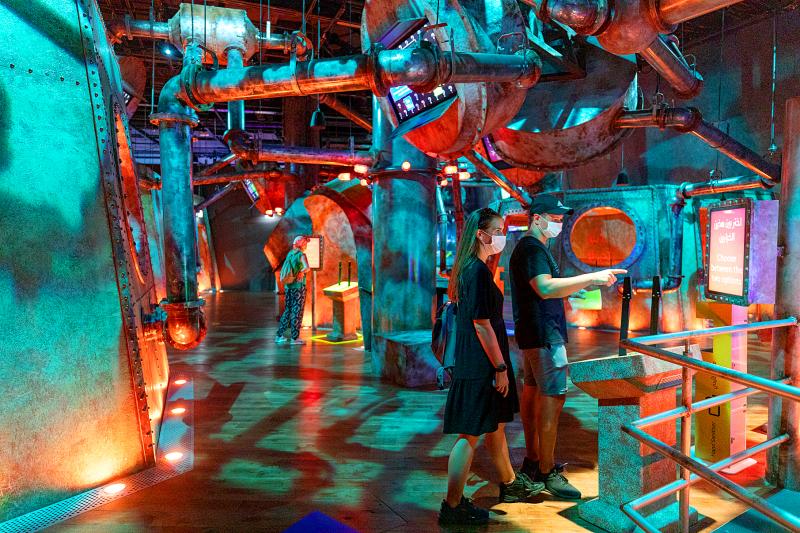Dubai has created a “new city” for Expo 2020 that would exist for decades, the head of the event told reporters, saying that most of the site would remain in use after the six-month world fair.
The US$7 billion, purpose-built showground occupies a vast site on Dubai’s outskirts, with hundreds of pavilions and exhibitions sprawling across an area twice the size of Monaco.
Thousands of people toured the fair on its opening day on Friday, braving hot temperatures as the COVID-19 pandemic-delayed world fair finally opened its doors one year late.

Photo: Bloomberg
Visitors strolled or rode electric bicycles around the huge showground. As temperatures touched 38°C, robot information systems buzzed down the shaded boulevards and formation jets plumed colored smoke overhead.
Dubai, one of the seven United Arab Emirates, is hoping to attract millions of visitors in a boost to its profile and standing during the fair. Visitor numbers were not immediately available for day one, but crowds were light and attendance appeared respectable rather than busy.
Expo 2020, which has sustainability as one of its main themes, wraps up in March.
However, Expo 2020 director-general Reem al-Hashimi said the lavish, largely air-conditioned development would not go to waste.
“It was never an investment to host an expo, it was an investment to create a new city that is equal distance between Dubai and Abu Dhabi, and really the city of the future,” she said in an interview.
“That investment goes into a city to 2040, 2050 and beyond. In addition to that, we have also made a commitment not to dismantle all expo-related facilities,” she said.
“Everything that we’re building, a very large majority, over 90 percent or so, will actually remain for that future city,” she added.
The expo project is connected to the Dubai metro and lies en route to the capital, Abu Dhabi, the richest and most powerful of the emirates.
Expo is intended to draw millions of foreign visitors, but pandemic-related travel restrictions worldwide are likely to have a dampening effect.
Whether the 5G-enabled site thrives or languishes after the expo depends on what businesses can be persuaded to base themselves there.
“Given the focus on technology and sustainability, we’re looking to attract industries, residents that are inclined to operate in those spaces,” said al-Hashimi, who is also the Emirati minister of state for international cooperation.
“So in part we’re looking at industries related to climate or green technology if you will, a lot around ag-tech. There’s an interesting combination of new sectors that have emerged that we’re going to be able hopefully to capitalize on by having this expo,” she said.
The expo’s sustainability measures include Terra, an enormous, satellite dish-shaped construction that is powered by nearly 5,000 solar panels and recycles its own water.
There are also a number of activities on climate and biodiversity, an especially pressing topic in the oil-rich Persian Gulf, one of the world’s hottest regions.
“There was a real conscious decision when we laid out our people and planet program to look at how the expo activities ... could positively contribute,” al-Hashimi said.
“Large global events in general don’t look at long-term sustainable measures,” she added. “But given that this site will remain almost in its entirety, in legacy, then we are proud to be able to contribute to the larger sustainable agenda.”

Taiwan Semiconductor Manufacturing Co (TSMC, 台積電) last week recorded an increase in the number of shareholders to the highest in almost eight months, despite its share price falling 3.38 percent from the previous week, Taiwan Stock Exchange data released on Saturday showed. As of Friday, TSMC had 1.88 million shareholders, the most since the week of April 25 and an increase of 31,870 from the previous week, the data showed. The number of shareholders jumped despite a drop of NT$50 (US$1.59), or 3.38 percent, in TSMC’s share price from a week earlier to NT$1,430, as investors took profits from their earlier gains

In a high-security Shenzhen laboratory, Chinese scientists have built what Washington has spent years trying to prevent: a prototype of a machine capable of producing the cutting-edge semiconductor chips that power artificial intelligence (AI), smartphones and weapons central to Western military dominance, Reuters has learned. Completed early this year and undergoing testing, the prototype fills nearly an entire factory floor. It was built by a team of former engineers from Dutch semiconductor giant ASML who reverse-engineered the company’s extreme ultraviolet lithography (EUV) machines, according to two people with knowledge of the project. EUV machines sit at the heart of a technological Cold

Taiwan’s long-term economic competitiveness will hinge not only on national champions like Taiwan Semiconductor Manufacturing Co. (TSMC, 台積電) but also on the widespread adoption of artificial intelligence (AI) and other emerging technologies, a US-based scholar has said. At a lecture in Taipei on Tuesday, Jeffrey Ding, assistant professor of political science at the George Washington University and author of "Technology and the Rise of Great Powers," argued that historical experience shows that general-purpose technologies (GPTs) — such as electricity, computers and now AI — shape long-term economic advantages through their diffusion across the broader economy. "What really matters is not who pioneers

TAIWAN VALUE CHAIN: Foxtron is to fully own Luxgen following the transaction and it plans to launch a new electric model, the Foxtron Bria, in Taiwan next year Yulon Motor Co (裕隆汽車) yesterday said that its board of directors approved the disposal of its electric vehicle (EV) unit, Luxgen Motor Co (納智捷汽車), to Foxtron Vehicle Technologies Co (鴻華先進) for NT$787.6 million (US$24.98 million). Foxtron, a half-half joint venture between Yulon affiliate Hua-Chuang Automobile Information Technical Center Co (華創車電) and Hon Hai Precision Industry Co (鴻海精密), expects to wrap up the deal in the first quarter of next year. Foxtron would fully own Luxgen following the transaction, including five car distributing companies, outlets and all employees. The deal is subject to the approval of the Fair Trade Commission, Foxtron said. “Foxtron will be